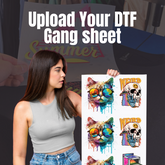Direct-to-Film (DTF) printing is a game-changing technology in the custom apparel industry, offering a versatile and efficient way to create vibrant, durable designs on various fabrics. Whether you’re new to the printing business or exploring alternatives to traditional methods like screen printing or DTG (Direct-to-Garment), DTF printing is worth understanding.
How Does DTF Printing Work?
DTF printing involves transferring a design onto a specialized film, which is then applied to a garment using heat and pressure. The process is straightforward but requires precision and the right equipment.
Steps in the DTF Printing Process:
- Design Creation: Start by preparing the design using graphic software. Ensure it’s optimized for vibrant colors and sharp details.
- Printing: Use a DTF printer to print the design onto a PET (polyethylene terephthalate) film. Specialized inks, including white ink for base layers, are used to achieve vibrant results.
- Powder Application: Apply a layer of adhesive powder to the printed design while the ink is still wet. This powder ensures the design adheres to the fabric during transfer.
- Curing: Heat the film to cure the adhesive powder, creating a solid bond.
- Transfer: Place the film onto the fabric and use a heat press to transfer the design. Peel off the film after cooling to reveal the final print.
Benefits of DTF Printing
DTF printing offers several advantages that make it a popular choice for custom apparel businesses:
- Versatility: Unlike DTG, which is best suited for cotton fabrics, DTF works on various materials, including polyester, blends, nylon, and even leather.
-
Durability: The adhesive powder and curing process result in prints that withstand washing and wear.

-
Vivid Colors: DTF delivers vibrant, high-quality prints on both light and dark fabrics.



- Cost-Effective for Small Runs: With minimal setup costs, DTF is ideal for small-batch or one-off orders.
- No Pre-Treatment Required: Unlike DTG, there’s no need to pre-treat garments before printing.
- Ease of Use: The process is straightforward, making it accessible to beginners and experienced printers alike.
DTF vs. Other Printing Methods
|
Feature |
DTF Printing |
DTG Printing |
Screen Printing |
|
Fabric Compatibility |
Works on various fabrics, including synthetics |
Best for cotton and blends |
Limited to specific materials |
|
Setup Cost |
Low |
Medium |
High due to stencil creation |
|
Durability |
Highly durable and washable |
Durable but may fade over time |
Extremely durable |
|
Production Speed |
Fast for small runs |
Slower due to pre-treatment |
Best for large batches |
|
Color Range |
Excellent on dark and light fabrics |
Great for detailed designs |
Limited by stencil complexity |
Common Applications of DTF Printing
DTF printing is widely used in the custom apparel industry and beyond. Some common applications include:
- T-Shirts: Create custom designs for casual and promotional wear.
- Hoodies: Print bold, durable graphics on thicker fabrics.
- Sportswear: Ideal for polyester and moisture-wicking materials.
- Bags and Accessories: Add logos or custom designs to tote bags, backpacks, and more.
- Custom Merchandise: Perfect for small businesses offering personalized products.
Getting Started with DTF Printing
To begin your DTF printing journey, you’ll need the right tools and materials:
- DTF Printer: A specialized printer with white ink capability.
- PET Film: High-quality transfer film designed for DTF printing.
- Adhesive Powder: Ensures proper adhesion to fabrics.
- Heat Press: Essential for transferring designs onto garments.
- Inks: Use compatible, high-quality DTF inks for the best results.
Investing in quality equipment and materials is crucial for achieving professional-grade prints.
Conclusion
DTF printing is a revolutionary method that offers unparalleled versatility and quality for custom apparel. Whether you’re looking to expand your printing business or start a new venture, DTF technology provides an efficient, cost-effective solution for producing vibrant, durable designs on a variety of fabrics.
If you’re ready to explore the possibilities of DTF printing, contact us for expert guidance and equipment recommendations!







